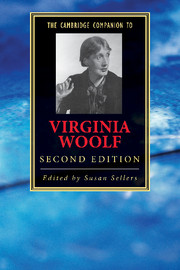Book contents
- Frontmatter
- 1 Bloomsbury
- 2 Virginia Woolf’s early novels: Finding a voice
- 3 From Mrs Dalloway to The Waves: New elegy and lyric experimentalism
- 4 The novels of the 1930s and the impact of history
- 5 Virginia Woolf’s essays
- 6 Virginia Woolf, modernism and modernity
- 7 The socio-political vision of the novels
- 8 Woolf’s feminism and feminism’s Woolf
- 9 Virginia Woolf and sexuality
- 10 Virginia Woolf, Empire and race
- 11 Virginia Woolf and visual culture
- 12 Virginia Woolf and the public sphere
- Guide to further reading
- Index
9 - Virginia Woolf and sexuality
Published online by Cambridge University Press: 28 July 2010
- Frontmatter
- 1 Bloomsbury
- 2 Virginia Woolf’s early novels: Finding a voice
- 3 From Mrs Dalloway to The Waves: New elegy and lyric experimentalism
- 4 The novels of the 1930s and the impact of history
- 5 Virginia Woolf’s essays
- 6 Virginia Woolf, modernism and modernity
- 7 The socio-political vision of the novels
- 8 Woolf’s feminism and feminism’s Woolf
- 9 Virginia Woolf and sexuality
- 10 Virginia Woolf, Empire and race
- 11 Virginia Woolf and visual culture
- 12 Virginia Woolf and the public sphere
- Guide to further reading
- Index
Summary
Language is the still unborn. I cannot say what I feel.
But I feel it! . . . I can see it. I can touch it, I cannot say it.
Nicholas to Eleanor (Draft Y5, p. 113)Sexuality and modernism
Virginia Woolf's prominence among early twentieth-century feminist, modernist and Bloomsbury innovators is well established, her iconoclasm most often discussed in terms of her feminist, pacifist, anti-imperialist and aesthetic theories. In Virginia Woolf as Feminist, Naomi Black aptly describes Woolf's feminism as 'deeply radical', 'drastic, basic, transformational'. Woolf called for radical reinventions of gender norms - 'For the degradation of being a slave is only equalled by the degradation of being a master.' Her pacifism was equally thoroughgoing and lifelong: her 1919 vow to oppose 'any domination of one over another; any leadership, any imposition of the will' (D1, p. 256, emphasis added) produced modernist classics that expose the roots of war and empire in habits of dominance and submission instilled at every level of private and public life.
Modernism is widely associated with innovation, alienation and abrupt breaks with past traditions. As Suzette Henke notes, Woolf's name is a 'watchword' for modernist innovation. When defining herself as 'modern', Woolf speaks in terms of fundamental transformations, profound alienation from existing traditions, and unmitigated breaks with the past: thus her claim that around 1910 'human character [itself] changed', and her comparison of axes 'breaking . . . crashing . . . destr[oying]' to modernist aims. As early as 1919, at the beginning of her writing career, Woolf writes, '& as the current answers don't do, one has to grope for a new one', and she rejects the realist conventions of her literary predecessors, Arnold Bennett (1867-1931) and Thackeray (1811-63), as impossible 'if one had the least respect for one's soul' (D1, p. 259).
- Type
- Chapter
- Information
- The Cambridge Companion to Virginia Woolf , pp. 180 - 196Publisher: Cambridge University PressPrint publication year: 2010
- 3
- Cited by

